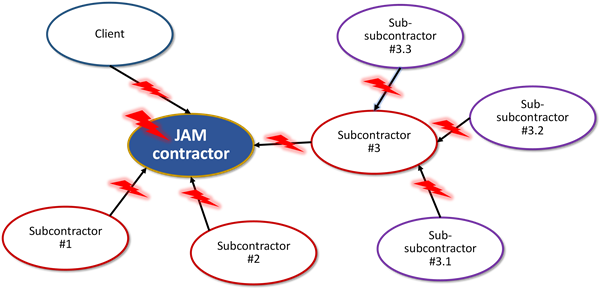Here are some Tools for You
Project Business Management
SERIES ARTICLE
By Oliver F. Lehmann
Munich, Germany

“Too swift arrives as tardy as too slow.”
William Shakespeare
Summary
A vendor in project business typically has three major goals: Making customers happy, generating profit, and protecting the own liquidity. These goals must be achieved in a high risk environment. What tools are at hand for the vendor as an organization or an individual to achieve them?
The Boon and Bane of Project Business Management
The practices of Project Business Management can be successfully applied when there are at least two players in a project, a client and a vendor. Often, the number of players is much larger, when contractors create large networks with other suppliers that also act as contractors, or as subcontractors, consultants, and many more. All these companies have expectations what they want to gain from the business. One of these expectations is naturally to bring money home.
The following pages will describe the problems meeting that expectation and recommend tools to improve the monetary benefits from the project contract.
When you work for a vendor of services and products for one or more paying customers, or when you are a self-employed contractor as a one-person business, your job can be a highly profitable business. It can be financially rewarding.
If you are among those who say “By lifting others we are blessed”[1], it is also satisfying to see how one can help customers achieve their objectives, develop products or services, drive improvements and transformations that the client alone would be unable to do, and help companies be more innovative and survive in fast changing markets. For this group of people, the payment is not the singular purpose of their work, but the confirmation that it is done well and the necessary basis to secure the presence and build the future. The sense of achievement is clearly what drives many professionals, self-employed or inside vendor companies, and the profitability derived from projects and their contribution to the own liquidity is one of several success metrics.
These are the successful contractors.
However, there are also contractor companies that are doing much worse. I call them “JAMs” for “Just about managing” in my book “Project Business Management”[2]. They somehow get by with the day, but they are unable to build the reserves needed for growth and development and for coping with the potentially hurtful surprises that are part of project business and its temporary and ever unique nature. This “JAMming” may originate in dysfunctionalities on the side of the customer. There may also be shortcomings on the side of their subcontractors, or of course also inside the own organization.
Figure 1 shows the multitude of sources that can disrupt business for a contractor inside a project supply network (PSN), and in essence, they can be found at all players involved.

Figure 1: Sources of business disruption for a contractor in a project supply network (PSN) in project business
In project supply networks (PSNs), troubles of one organization can impact other players and like a complex system of rows of falling dominoes affect the entire project, possibly driving it and its contributing organizations into existential crisis.
More…
To read entire article, click here
Editor’s note: This series of articles is by Oliver Lehmann, author of the book “Project Business Management” (ISBN 9781138197503), published by Auerbach / Taylor & Francis in 2018. See author profile below.
How to cite this article: Lehmann, O. (2019). Are You Ready for Business Success as a Project Vendor? Here are some Tools for You; Series on Project Business Management; PM World Journal, Vol. VIII, Issue V, June. Available online at https://pmworldlibrary.net/wp-content/uploads/2019/06/pmwj82-Jun2019-Lehmann-Are-You-Ready-for-Business-Success-as-a-Project-Vendor.pdf
About the Author

Oliver F. Lehmann
Munich, Germany
![]()
Oliver F. Lehmann, MSc., PMP, is a project management author, consultant, speaker and teacher. He studied Linguistics, Literature and History at the University of Stuttgart and Project Management at the University of Liverpool, UK, where he holds a Master of Science Degree. Oliver has trained thousands of project managers in Europe, USA and Asia in methodological project management with a focus on certification preparation. In addition, he is a visiting lecturer at the Technical University of Munich.
He has been a member and volunteer at PMI, the Project Management Institute, since 1998, and served five years as the President of the PMI Southern Germany Chapter until April 2018. Between 2004 and 2006, he contributed to PMI’s PM Network magazine, for which he provided a monthly editorial on page 1 called “Launch”, analyzing troubled projects around the world.
Oliver believes in three driving forces for personal improvement in project management: formal learning, experience and observations. He resides in Munich, Bavaria, Germany and can be contacted at oliver@oliverlehmann.com.
Oliver Lehmann is the author of “Situational Project Management: The Dynamics of Success and Failure” (ISBN 9781498722612), published by Auerbach / Taylor & Francis in 2016 and of “Project Business Management” (ISBN 9781138197503), published by Auerbach / Taylor & Francis in 2018.
To view other works by Oliver Lehmann, visit his author showcase in the PM World Library at https://pmworldlibrary.net/authors/oliver-f-lehmann/
[1] (Ingersoll, 1902)
[2] (Lehmann, 2018)









